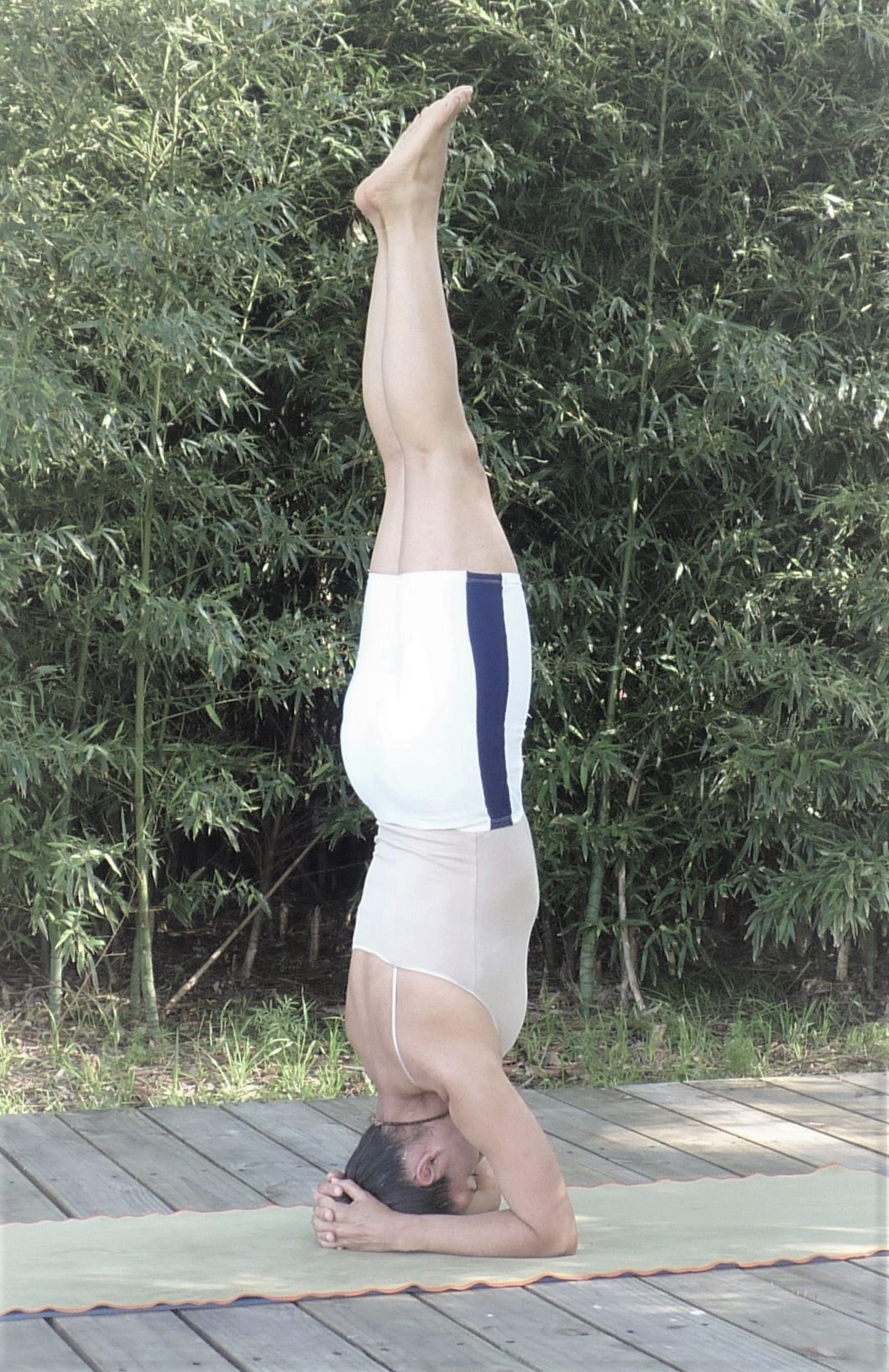|

|
Asana tip
(by Krishna Darshan)
 SIRSHASANA, the headstand SIRSHASANA, the headstand
This is called “the king of asanas” by the yogis, because of its innumerable benefits.
In the physical level, this posture increases the venous return into the heart, giving the heart muscle a stretch, which helps for a better contraction and strengthening of the heart muscle.
The blood from the legs is easily brought back to the heart by its on weight and the gravity force, alleviating the work of the heart to pump up all this blood, and bringing a very good blood supply to the brain and other organs of the head and neck. The brain cells are the ones that are more sensitive to oxygen deficiency. By combining the natural ease of the blood circulation to the head region with the deep breathing while holding the posture, the headstand ensures a good oxygen supply to the brain, which improves the neuronal and mental faculties, enhancing and awakened lucid and concentrated state of mind.
It is also one of the best postures to prevent or reverse varicose veins, because the pressure of the blood on the veins and valves is reverted, helping on their healing.
Sirshasana massages the internal organs and strengthens the “agni” or digestive fire, aiding in the digestion, absorption and elimination processes.
On the psychological level, this posture helps on removing fear and inner insecurity. It develops body-mind coordination, good memory, focus, grounding, mental stability and concentration, aiding to the practice of meditation.
On the spiritual level, this asana works wonders by helping the union of Prana and Apana, the two poles of the vital energy.
Prana’s natural tendency is to move upwards, while apana’s tendency is to move downwards, meaning they flow away from each other, creating an inner state of duality and disharmony.
But when the body is inverted and the posture held for some time, their natural flow brings them towards each other helping the union or “connection” to take place between these two forces. (only after the nadis have been purified by pranayama, long practice and proper diet.)
This union awakens the dormant psychic and spiritual forces and produces a change in the consciousness, which induces the meditative state, which is actually the goal of hatha yoga.
This asana is also of great help to sublimate the sexual energy into Ojas Shakti and spiritual awareness, because of the reversal of the downwards flow of the apana.
By reverting the flow of the apana, the downward flow and discharge of the sexual energy is reverted, diminishing the sexual urge and helping in the natural practice of brahmacharya without the adversities of repression.
Common mistakes:
Beginners usually try to jump up into the postures too quickly, losing their balance and falling, which can create injuries and further fears.
Lear from a qualified teacher the 8 steps to get up into the posture safely.
Once in the posture, the body should be kept perfectly straight, avoiding excessive curvature (lordosis) on the lower back or in the neck.
Another common mistake is putting all the weigh on the head, which strains the neck.
The weight of the body should be well distributed between the head and the elbows/forearms, in such a way that only one third of the weight is really on the head.
The right placement of the hands and elbows, forming a triangle, provides a “tripod” kind of support, alleviating the weight on the head and neck.
Practice a few rounds of the Dolphin exercise for some time to develop the strength of your arms and shoulders before you attempt the headstand.
Breathing
Make sure the breath is never agitated or panting. Neither should you hold your breath while on the posture. Always breathe calmly, slowly and deeply. This will help you to relax, find your balance, focus your mind and avoid your blood pressure to get high.
Sometimes, some people experience a bit of difficulty to breath trough the nose in the beginning of the posture. But if you just hold the posture long enough and breathe very slowly and calmly, the nostrils and nadis will open up and your breath will become easy.
Do not breathe trough the mouth.
Counter indications:
Do not practice sirshasana if you have:
high blood pressure, heart problems, neck injuries, glaucoma, detached retina, recent surgery or any bleeding on the area of the head or neck.
Practice only with an empty stomach.
Do not practice while pregnant of during the first days of menstruation.
Demostration video:
Click on the following link to watch a short video of how to come up stap by step into the headstand.
https://www.youtube.com/watch?v=ALqa3FfOtU8&list=PLjbZGAhWonlD8F2sqlbJQR8PMDi7E6L4c&index=6
Once you are steady and well grounded in the basic posture, you can try some of the leg movements, which help in pumping blood towards the head , and relieve pressure from varicose veins in the legs, also enhancing balance and concentration. At the end, it is possible to move into vrischikasana or the scorpion pose, which exercises further balance and backwards bending of the spine
After you do the variations, stay totally quiet in the basic straight posture for a few minutes according to your capacity.
At the very end, rest your back by staying in the child’s pose for one minute, then lie down in Savasana.
If you want to share this article please do it by sharing the link to this page. For other uses please write to us at info@yoga-elsilencio.com
|
|

